[English] 日本語
 Yorodumi
Yorodumi- PDB-3j9p: Structure of the TRPA1 ion channel determined by electron cryo-mi... -
+ Open data
Open data
- Basic information
Basic information
| Entry | Database: PDB / ID: 3j9p | ||||||
|---|---|---|---|---|---|---|---|
| Title | Structure of the TRPA1 ion channel determined by electron cryo-microscopy | ||||||
 Components Components | Maltose-binding periplasmic protein, Transient receptor potential cation channel subfamily A member 1 chimera | ||||||
 Keywords Keywords |  TRANSPORT PROTEIN / TRANSPORT PROTEIN /  TRPA1 / TRP / transient / potential / TRPA1 / TRP / transient / potential /  receptor / receptor /  ion channel / ion channel /  membrane protein membrane protein | ||||||
| Function / homology |  Function and homology information Function and homology informationtemperature-gated cation channel activity / stereocilium bundle / detection of chemical stimulus involved in sensory perception of pain /  thermoception / thermoception /  TRP channels / channel activity / response to pain / cellular response to organic substance / detection of maltose stimulus / TRP channels / channel activity / response to pain / cellular response to organic substance / detection of maltose stimulus /  maltose binding ...temperature-gated cation channel activity / stereocilium bundle / detection of chemical stimulus involved in sensory perception of pain / maltose binding ...temperature-gated cation channel activity / stereocilium bundle / detection of chemical stimulus involved in sensory perception of pain /  thermoception / thermoception /  TRP channels / channel activity / response to pain / cellular response to organic substance / detection of maltose stimulus / TRP channels / channel activity / response to pain / cellular response to organic substance / detection of maltose stimulus /  maltose binding / maltose transport complex / maltose transport / maltodextrin transmembrane transport / intracellularly gated calcium channel activity / carbohydrate transmembrane transporter activity / ATP-binding cassette (ABC) transporter complex, substrate-binding subunit-containing / carbohydrate transport / detection of mechanical stimulus involved in sensory perception of pain / monoatomic ion transport / sensory perception of pain / response to cold / ATP-binding cassette (ABC) transporter complex / cell chemotaxis / response to organic substance / calcium ion transmembrane transport / maltose binding / maltose transport complex / maltose transport / maltodextrin transmembrane transport / intracellularly gated calcium channel activity / carbohydrate transmembrane transporter activity / ATP-binding cassette (ABC) transporter complex, substrate-binding subunit-containing / carbohydrate transport / detection of mechanical stimulus involved in sensory perception of pain / monoatomic ion transport / sensory perception of pain / response to cold / ATP-binding cassette (ABC) transporter complex / cell chemotaxis / response to organic substance / calcium ion transmembrane transport /  calcium channel activity / intracellular calcium ion homeostasis / response to organic cyclic compound / cellular response to hydrogen peroxide / outer membrane-bounded periplasmic space / protein homotetramerization / calcium channel activity / intracellular calcium ion homeostasis / response to organic cyclic compound / cellular response to hydrogen peroxide / outer membrane-bounded periplasmic space / protein homotetramerization /  periplasmic space / cell surface receptor signaling pathway / response to xenobiotic stimulus / DNA damage response / periplasmic space / cell surface receptor signaling pathway / response to xenobiotic stimulus / DNA damage response /  membrane / identical protein binding / membrane / identical protein binding /  plasma membrane plasma membraneSimilarity search - Function | ||||||
| Biological species |   Escherichia coli (E. coli) Escherichia coli (E. coli)  Homo sapiens (human) Homo sapiens (human) | ||||||
| Method |  ELECTRON MICROSCOPY / ELECTRON MICROSCOPY /  single particle reconstruction / single particle reconstruction /  cryo EM / Resolution: 4.24 Å cryo EM / Resolution: 4.24 Å | ||||||
 Authors Authors | Paulsen, C.E. / Armache, J.-P. / Gao, Y. / Cheng, Y. / Julius, D. | ||||||
 Citation Citation |  Journal: Nature / Year: 2015 Journal: Nature / Year: 2015Title: Structure of the TRPA1 ion channel suggests regulatory mechanisms. Authors: Candice E Paulsen / Jean-Paul Armache / Yuan Gao / Yifan Cheng / David Julius /  Abstract: The TRPA1 ion channel (also known as the wasabi receptor) is a detector of noxious chemical agents encountered in our environment or produced endogenously during tissue injury or drug metabolism. ...The TRPA1 ion channel (also known as the wasabi receptor) is a detector of noxious chemical agents encountered in our environment or produced endogenously during tissue injury or drug metabolism. These include a broad class of electrophiles that activate the channel through covalent protein modification. TRPA1 antagonists hold potential for treating neurogenic inflammatory conditions provoked or exacerbated by irritant exposure. Despite compelling reasons to understand TRPA1 function, structural mechanisms underlying channel regulation remain obscure. Here we use single-particle electron cryo- microscopy to determine the structure of full-length human TRPA1 to ∼4 Å resolution in the presence of pharmacophores, including a potent antagonist. Several unexpected features are revealed, including an extensive coiled-coil assembly domain stabilized by polyphosphate co-factors and a highly integrated nexus that converges on an unpredicted transient receptor potential (TRP)-like allosteric domain. These findings provide new insights into the mechanisms of TRPA1 regulation, and establish a blueprint for structure-based design of analgesic and anti-inflammatory agents. | ||||||
| History |
|
- Structure visualization
Structure visualization
| Movie |
 Movie viewer Movie viewer |
|---|---|
| Structure viewer | Molecule:  Molmil Molmil Jmol/JSmol Jmol/JSmol |
- Downloads & links
Downloads & links
- Download
Download
| PDBx/mmCIF format |  3j9p.cif.gz 3j9p.cif.gz | 460.1 KB | Display |  PDBx/mmCIF format PDBx/mmCIF format |
|---|---|---|---|---|
| PDB format |  pdb3j9p.ent.gz pdb3j9p.ent.gz | 312.6 KB | Display |  PDB format PDB format |
| PDBx/mmJSON format |  3j9p.json.gz 3j9p.json.gz | Tree view |  PDBx/mmJSON format PDBx/mmJSON format | |
| Others |  Other downloads Other downloads |
-Validation report
| Arichive directory |  https://data.pdbj.org/pub/pdb/validation_reports/j9/3j9p https://data.pdbj.org/pub/pdb/validation_reports/j9/3j9p ftp://data.pdbj.org/pub/pdb/validation_reports/j9/3j9p ftp://data.pdbj.org/pub/pdb/validation_reports/j9/3j9p | HTTPS FTP |
|---|
-Related structure data
| Related structure data |  6267MC  6268C  6269C M: map data used to model this data C: citing same article ( |
|---|---|
| Similar structure data | |
| EM raw data |  EMPIAR-10024 (Title: Human TRPA1 ion channel with agonist AITC / Data size: 453.0 EMPIAR-10024 (Title: Human TRPA1 ion channel with agonist AITC / Data size: 453.0 Data #1: TRP ion channel dataset [picked particles - single frame - processed]) |
- Links
Links
- Assembly
Assembly
| Deposited unit | 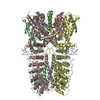
|
|---|---|
| 1 |
|
- Components
Components
| #1: Protein | Mass: 172575.562 Da / Num. of mol.: 4 / Fragment: SEE REMARK 999 Source method: isolated from a genetically manipulated source Source: (gene. exp.) Escherichia coli, Homo sapiens / Gene: malE, ANKTM1, TRPA1 / Cell line (production host): HEK293 GnTi- / Production host:   Homo sapiens (human) / References: UniProt: P0AEX9, UniProt: O75762 Homo sapiens (human) / References: UniProt: P0AEX9, UniProt: O75762Sequence details | PROTEIN IS A CHIMERA COMPRISING | |
|---|
-Experimental details
-Experiment
| Experiment | Method:  ELECTRON MICROSCOPY ELECTRON MICROSCOPY |
|---|---|
| EM experiment | Aggregation state: PARTICLE / 3D reconstruction method:  single particle reconstruction single particle reconstruction |
- Sample preparation
Sample preparation
| Component | Name: Recombinant human TRPA1 ion channel / Type: COMPLEX |
|---|---|
| Buffer solution | Name: 20 mM HEPES, 150 mM NaCl, 1 mM DTT, 1 mM IP6 / pH: 8 / Details: 20 mM HEPES, 150 mM NaCl, 1 mM DTT, 1 mM IP6 |
| Specimen | Conc.: 0.5 mg/ml / Embedding applied: NO / Shadowing applied: NO / Staining applied : NO / Vitrification applied : NO / Vitrification applied : YES : YES |
| Specimen support | Details: 400 mesh holey carbon |
Vitrification | Instrument: FEI VITROBOT MARK I / Cryogen name: ETHANE / Temp: 120 K / Humidity: 100 % Details: Blot for 7 seconds before plunging into liquid ethane (FEI VITROBOT MARK I). Method: Blot for 7 seconds before plunging. |
- Electron microscopy imaging
Electron microscopy imaging
| Experimental equipment |  Model: Tecnai Polara / Image courtesy: FEI Company |
|---|---|
| Microscopy | Model: FEI POLARA 300 / Date: Jul 18, 2014 Details: Gatan K2 Summit in super-resolution counting mode. Motion correction as described in Li et al. (2013) Nature Methods. |
| Electron gun | Electron source : :  FIELD EMISSION GUN / Accelerating voltage: 300 kV / Illumination mode: FLOOD BEAM FIELD EMISSION GUN / Accelerating voltage: 300 kV / Illumination mode: FLOOD BEAM |
| Electron lens | Mode: BRIGHT FIELD Bright-field microscopy / Nominal magnification: 31000 X / Calibrated magnification: 31000 X / Nominal defocus max: 2800 nm / Nominal defocus min: 1500 nm / Cs Bright-field microscopy / Nominal magnification: 31000 X / Calibrated magnification: 31000 X / Nominal defocus max: 2800 nm / Nominal defocus min: 1500 nm / Cs : 2 mm : 2 mm |
| Specimen holder | Temperature: 120 K |
| Image recording | Electron dose: 21 e/Å2 / Film or detector model: GATAN K2 (4k x 4k) Details: Gatan K2 Summit in super-resolution counting mode. Motion correction as described in Li et al. (2013) Nature Methods. |
| Image scans | Num. digital images: 1160 |
| Radiation | Protocol: SINGLE WAVELENGTH / Monochromatic (M) / Laue (L): M / Scattering type: x-ray |
| Radiation wavelength | Relative weight: 1 |
- Processing
Processing
| EM software | Name: RELION / Category: 3D reconstruction | ||||||||||||
|---|---|---|---|---|---|---|---|---|---|---|---|---|---|
CTF correction | Details: Each particle | ||||||||||||
| Symmetry | Point symmetry : C4 (4 fold cyclic : C4 (4 fold cyclic ) ) | ||||||||||||
3D reconstruction | Method: Maximum likelihood / Resolution: 4.24 Å / Resolution method: FSC 0.143 CUT-OFF / Num. of particles: 43585 / Nominal pixel size: 1.2156 Å / Actual pixel size: 1.2156 Å / Symmetry type: POINT | ||||||||||||
| Refinement step | Cycle: LAST
|
 Movie
Movie Controller
Controller


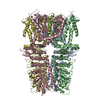
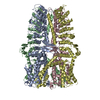
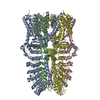
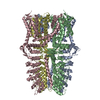

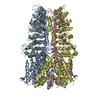
 PDBj
PDBj




